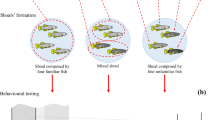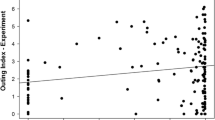Abstract
Living in a group offers the chance to follow the choices and the behaviours of other individuals. Following a group mate might confer fitness advantages if the group mate knows about resources such as food or shelters. Shoaling fish often follow larger group mates which, in most species, are generally older and therefore more experienced. Yet, the effect of individuals’ characteristics other than size on following behaviour remains to be understood. For example, familiar fish and female shoals have been reported as more cohesive, which might be due to a differential tendency to follow in relation to familiarity and sex. Here, we investigated whether size, familiarity, sex, and the interaction between these factors affect fish following behaviour. We observed pairs of differently sized Mediterranean killifish, Aphanius fasciatus, exploring a new environment, and we recorded whether the rear fish followed the front fish when the latter changed swimming direction. In female and male pairs, and in unfamiliar pairs, smaller fish were more likely to follow the directional change of the larger fish than vice versa. In mixed-sex pairs and in familiar pairs, however, size did not affect following behaviour and larger fish followed as much as smaller fish did. Our results revealed that killifish’s following decisions are determined by the size of the individuals, their level of familiarity, and their sex. These characteristics may have a notable impact on the behaviour of fish groups in nature.



Similar content being viewed by others
References
Atton N, Galef BJ, Hoppitt W, Webster MM, Laland KN (2014) Familiarity affects social network structure and discovery of prey patch locations in foraging stickleback shoals. Proc Royal Soc B-Biol Sci 281:20140579
Avery ML (1994) Finding good food and avoiding bad food: does it help to associate with experienced flockmates? Anim Behav 48:1371–1378
Boisclair D, Leggett WC (1989) Among-population variability of fish growth: II. Influence of prey type. Can J Fish Aquat Sci 46:468–482
Burns AL, Herbert-Read JE, Morrell LJ, Ward AJ (2012) Consistency of leadership in shoals of mosquitofish (Gambusia holbrooki) in novel and in familiar environments. PLoS One 7:e36567
Cattelan S, Griggio M (2018) Within-shoal phenotypic homogeneity affects shoaling preference in a killifish. Biol Lett 14:20180293
Cattelan S, Lucon-Xiccato T, Pilastro A, Griggio M (2017) Is the mirror test a valid measure of fish sociability? Anim Behav 127:109–116
Cavraro F, Zucchetta M, Torricelli P, Malavasi S (2013) Sexual dimorphism of vertical bar patterning in the South European toothcarp Aphanius fasciatus. J Fish Biol 82:1758–1764
Chivers DP, Brown GE, Smith RJF (1995) Familiarity and shoal cohesion in fathead minnows (Pimephales promelas): implications for antipredator behaviour. Can J Zool 73:955–960
Cote J, Fogarty S, Weinersmith K, Brodin T, Sih A (2010) Personality traits and dispersal tendency in the invasive mosquitofish (Gambusia affinis). Proc Royal Soc B-Biol Sci 277:1571–1579
Cote J, Fogarty S, Sih A (2012) Individual sociability and choosiness between shoal types. Anim Behav 83:1469–1476
Couzin ID, Krause J, James R, Ruxton GD, Franks NR (2002) Collective memory and spatial sorting in animal groups. J Theor Biol 218:1–11
Croft DP, Krause J, James R (2004) Social networks in the guppy (Poecilia reticulata). Proc Royal Soc B-Biol Sci 271:S516–S519
Dadda M, Nepomnyashchikh VA, Izvekov EI, Bisazza A (2012) Individual-level consistency of different laterality measures in the goldbelly topminnow. Behav Neurosci 126:845–849
Dugatkin LA, Godin JGJ (1993) Female mate copying in the guppy (Poecilia reticulata): age-dependent effects. Behav Ecol 4:289–292
Dyer JR, Johansson A, Helbing D, Couzin ID, Krause J (2009) Leadership, consensus decision making and collective behaviour in humans. Philos Trans Royal Soc B-Biol Sci 364:781–789
Flack A, Pettit B, Freeman R, Guilford T, Biro D (2012) What are leaders made of? The role of individual experience in determining leader–follower relations in homing pigeons. Anim Behav 83:703–709
Harcourt JL, Sweetman G, Manica A, Johnstone RA (2010) Pairs of fish resolve conflicts over coordinated movement by taking turns. Curr Biol 20:156–160
Hesse S, Anaya-Rojas JM, Frommen JG, Thünken T (2015) Social deprivation affects cooperative predator inspection in a cichlid fish. Open Sci 2:140451
Hofmann HA, Fernald RD (2000) Social status controls somatostatin neuron size and growth. J Neurosci 20:4740–4744
Huffman MA (1996) Acquisition of innovative cultural behaviors in nonhuman primates: a case study of stone-handling, a socially transmitted behavior in Japanese macaques. In: Heyes CM, Galef BG Jr (eds) Social learning in animals: the roots of culture. Academic Press, San Diego, pp 267–286
Ioannou CC, Singh M, Couzin ID (2015) Potential leaders trade off goal-oriented and socially oriented behavior in mobile animal groups. Am Nat 186:284–293
Jolles JW, Fleetwood-Wilson A, Nakayama S, Stumpe MC, Johnstone RA, Manica A (2014) The role of previous social experience on risk-taking and leadership in three-spined sticklebacks. Behav Ecol 25:1395–1401
Kiflawi M, Mazeroll AI (2006) Female leadership during migration and the potential for sex-specific benefits of mass spawning in the brown surgeonfish (Acanthurus nigrofuscus). Environ Biol Fish 76:19–23
Krause J (1993) The relationship between foraging and shoal position in a mixed shoal of roach (Rutilus rutilus) and chub (Leuciscus cephalus): a field study. Oecologia 93:356–359
Krause J, Ruxton GD (2002) Living in groups. Oxford University Press, Oxford
Laland KN (2004) Social learning strategies. Anim Learn Behav 32:4–14
Leca JB, Gunst N, Thierry B, Petit O (2003) Distributed leadership in semifree-ranging white-faced capuchin monkeys. Anim Behav 66:1045–1052
Leonardos I, Sinis A (1998) Reproductive strategy of Aphanius fasciatus Nardo, 1827 (Pisces: Cyprinodontidae) in the Mesolongi and Etolikon lagoons (W. Greece). Fish Res 35:171–181
Leonardos I, Sinis A (1999) Population age and sex structure of Aphanius fasciatus Nardo, 1827 (Pisces: Cyprinodontidae) in the Mesolongi and Etolikon lagoons (W. Greece). Fish Res 40:227–235
Lucon-Xiccato T, Griggio M (2017) Shoal sex composition affects exploration in the Mediterranean killifish. Ethology 123:818–824
Lucon-Xiccato T, Dadda M, Gatto E, Bisazza A (2017a) Development and testing of a rapid method for measuring shoal size discrimination. Anim Cogn 20:149–157
Lucon-Xiccato T, Mazzoldi C, Griggio M (2017b) Sex composition modulates the effects of familiarity in new environment. Behav Process 140:133–138
Magurran AE, Garcia CM (2000) Sex differences in behaviour as an indirect consequence of mating system. J Fish Biol 57:839–857
McDonald ND, Rands SA, Hill F, Elder C, Ioannou CC (2016) Consensus and experience trump leadership, suppressing individual personality during social foraging. Sci Adv 2:e1600892
Moretz JA, Martins EP, Robison BD (2007) Behavioral syndromes and the evolution of correlated behavior in zebrafish. Behav Ecol 18:556–562
Nakayama S, Johnstone RA, Manica A (2012) Temperament and hunger interact to determine the emergence of leaders in pairs of foraging fish. PLoS One 7:e43747
Nakayama S, Harcourt JL, Johnstone RA, Manica A (2016) Who directs group movement? Leader effort versus follower preference in stickleback fish of different personality. Biol Lett 12:20160207
Partridge BL (1980) The effect of school size on the structure and dynamics of minnow schools. Anim Behav 28:68–77
Pillot MH, Gautrais J, Gouello J, Michelena P, Bon R (2010) Moving together: incidental leaders and naïve followers. Behav Process 83:235–241
Qasim SZ (1966) Sex-ratio in fish populations as a function of sexual difference in growth rate. Curr Sci 35:140–142
Reader SM, Laland KN (2000) Diffusion of foraging innovations in the guppy. Anim Behav 60:175–180
Reader SM, Kendal JR, Laland KN (2003) Social learning of foraging sites and escape routes in wild Trinidadian guppies. Anim Behav 66:729–739
Reebs SG (2001) Influence of body size on leadership in shoals of golden shiners, Notemigonus crysoleucas. Behav 138:797–809
Swaney W, Kendal J, Capon H, Brown C, Laland KN (2001) Familiarity facilitates social learning of foraging behaviour in the guppy. Anim Behav 62:591–598
Toth Z, Griggio M (2011) Leaders are more attractive: birds with bigger yellow breast patches are followed by more group-mates in foraging groups. PLoS One 6:e26605
Tupper M, Boutilier RG (1995) Effects of habitat on settlement, growth, and postsettlement survival of Atlantic cod (Gadus morhua). Can J Fish Aquat Sci 52:1834–1841
Utne-Palm AC, Hart PJ (2000) The effects of familiarity on competitive interactions between threespined sticklebacks. Oikos 91:225–232
Ward AJ, Hart PJ (2003) The effects of kin and familiarity on interactions between fish. Fish Fish 4:348–358
Ward AJ, Hoare DJ, Couzin ID, Broom M, Krause J (2002) The effects of parasitism and body length on positioning within wild fish shoals. J Anim Ecol 71:10–14
Webster MM (2016) Experience and motivation shape leader–follower interactions in fish shoals. Behav Ecol 28:77–84
Webster MM, Laland KN (2012) Social information, conformity and the opportunity costs paid by foraging fish. Behav Ecol Sociobiol 66:797–809
Wohlschlag DE (1962) Antartic fish growth and metabolic differences related to sex. Ecology 43:589–597
Wong MY, Munday PL, Buston PM, Jones GP (2008) Fasting or feasting in a fish social hierarchy. Curr Biol 18:R372–R373
Acknowledgements
We would like to thank the 2014 ‘Biodiversity and Behaviour’ class (Marine Biology course, Università di Padova) for help during the experiments, and Angelo Bisazza and Federica Poli for logistical support. We are indebted with Avelie Stuart and four anonymous reviewers for their constructive comments on the manuscript.
Funding
This work was supported by the Università di Padova under Grant ‘Progetto di Ricerca di Ateneo 2015’ to MG (grant no. PRAT 2015 CPDA153859).
Author information
Authors and Affiliations
Corresponding author
Ethics declarations
The experiments complied with the laws of Italy, the country in which they were performed (Decreto Legislativo 4 marzo 2014, n. 26), and they have been approved by Università di Padova’s Ethical Committee (protocol no. 10985). Fish sampling was conducted with permission from Veneto Region (protocol no. 207154, Decreto N. 20 del 14 maggio 2015, Legge Regionale 28 aprile 1998). No physically invasive manipulation was performed on fish that were released into their natural environment after the experiments.
Conflict of interest
The authors declare that they have no conflict of interest.
Additional information
Communicated by: Matthias Waltert
Publisher’s note
Springer Nature remains neutral with regard to jurisdictional claims in published maps and institutional affiliations.
Rights and permissions
About this article
Cite this article
Lucon-Xiccato, T., Anastasia, N., Mazzoldi, C. et al. Familiarity and sex modulate size-dependent following behaviour in the Mediterranean killifish. Sci Nat 106, 31 (2019). https://doi.org/10.1007/s00114-019-1630-0
Received:
Revised:
Accepted:
Published:
DOI: https://doi.org/10.1007/s00114-019-1630-0




